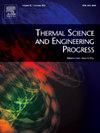Influence of operational modes on the system performance and exergy efficiency of carbon fiber film heater-assisted heat pump drying systems
IF 5.1
3区 工程技术
Q2 ENERGY & FUELS
引用次数: 0
Abstract
This study investigated the drying performance of apple slices using a closed-circuit heat pump drying (HPD) system enhanced by a carbon fiber film heater (CFFH) integrated under the trays. The motivation behind this research was to improve the coefficient of performance (COP) and drying uniformity of the HPD system through innovative heating strategies. It was hypothesized that different operational strategies of the CFFH would significantly affect the system’s performance and exergy efficiency. To test this, three different CFFH operating strategies were implemented: continuous operation with the HPD system (Case-I), simultaneous intermittent operation with the external condenser (Case-II), and simultaneous intermittent operation with the external evaporator (Case-III). The experimental results revealed that Case-III achieved the highest coefficient of performance for the heat pump (COPHP) at 4.44 and the highest coefficient of performance for the system (COPSYS) values at 3.34, while Case-I demonstrated the lowest values at 4.08 for COPHP and 2.98 for COPSYS. Compared to the HPD system without CFFH, Case-I yielded higher moisture extraction rate (MER) and specific energy consumption (SEC) values by 0.005 kg/h and 0.935 kg/kWh, respectively, while specific moisture extraction rate (SMER) values were 0.007 kg/kWh lower. Furthermore, the highest exergy efficiency of 90.7 % was observed in the capillary tube during Case-II, whereas the compressor in Case-I exhibited the lowest efficiency at 60.6 %. In conclusion, integrating CFFHs with the HPD system not only facilitated more uniform drying of the apple slices but also enhanced COPHP.
运行方式对碳纤维膜加热器辅助热泵干燥系统性能及火用效率的影响
本研究调查了使用集成在托盘下的碳纤维膜加热器(CFFH)的闭路热泵干燥(HPD)系统对苹果片的干燥性能。这项研究的动机是通过创新的加热策略提高 HPD 系统的性能系数(COP)和干燥均匀性。假设 CFFH 的不同操作策略会显著影响系统的性能和能效。为了验证这一点,我们采用了三种不同的 CFFH 运行策略:与 HPD 系统连续运行(案例 I)、与外部冷凝器同时间歇运行(案例 II)以及与外部蒸发器同时间歇运行(案例 III)。实验结果表明,Case-III 的热泵性能系数(COPHP)最高,为 4.44,系统性能系数(COPSYS)最高,为 3.34,而 Case-I 的 COPHP 性能系数(COPHP)最低,为 4.08,COPSYS 性能系数(COPHP)最低,为 2.98。与不含 CFFH 的 HPD 系统相比,案例 I 的抽湿率(MER)和比能耗(SEC)值分别高出 0.005 千克/小时和 0.935 千克/千瓦时,而比抽湿率(SMER)值则低 0.007 千克/千瓦时。此外,在案例 II 中,毛细管的能效最高,为 90.7%,而案例 I 中压缩机的能效最低,为 60.6%。总之,将 CFFHs 与 HPD 系统集成在一起,不仅有助于更均匀地干燥苹果片,还能提高 COPHP。
本文章由计算机程序翻译,如有差异,请以英文原文为准。
求助全文
约1分钟内获得全文
求助全文
来源期刊

Thermal Science and Engineering Progress
Chemical Engineering-Fluid Flow and Transfer Processes
CiteScore
7.20
自引率
10.40%
发文量
327
审稿时长
41 days
期刊介绍:
Thermal Science and Engineering Progress (TSEP) publishes original, high-quality research articles that span activities ranging from fundamental scientific research and discussion of the more controversial thermodynamic theories, to developments in thermal engineering that are in many instances examples of the way scientists and engineers are addressing the challenges facing a growing population – smart cities and global warming – maximising thermodynamic efficiencies and minimising all heat losses. It is intended that these will be of current relevance and interest to industry, academia and other practitioners. It is evident that many specialised journals in thermal and, to some extent, in fluid disciplines tend to focus on topics that can be classified as fundamental in nature, or are ‘applied’ and near-market. Thermal Science and Engineering Progress will bridge the gap between these two areas, allowing authors to make an easy choice, should they or a journal editor feel that their papers are ‘out of scope’ when considering other journals. The range of topics covered by Thermal Science and Engineering Progress addresses the rapid rate of development being made in thermal transfer processes as they affect traditional fields, and important growth in the topical research areas of aerospace, thermal biological and medical systems, electronics and nano-technologies, renewable energy systems, food production (including agriculture), and the need to minimise man-made thermal impacts on climate change. Review articles on appropriate topics for TSEP are encouraged, although until TSEP is fully established, these will be limited in number. Before submitting such articles, please contact one of the Editors, or a member of the Editorial Advisory Board with an outline of your proposal and your expertise in the area of your review.
 求助内容:
求助内容: 应助结果提醒方式:
应助结果提醒方式:


